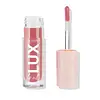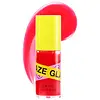What's inside
What's inside
 Key Ingredients
Key Ingredients

No key ingredients
 Benefits
Benefits

 Concerns
Concerns

 Ingredients Side-by-side
Ingredients Side-by-side

Hydrogenated Polyisobutene
EmollientSimmondsia Chinensis Seed Oil
EmollientDiisostearyl Malate
EmollientButyrospermum Parkii Butter
Skin ConditioningEthylene/Propylene/Styrene Copolymer
Butylene/Ethylene/Styrene Copolymer
Aroma
Polyethylene
AbrasiveMicrocrystalline Wax
Emulsion StabilisingPhenoxyethanol
PreservativeSilica Dimethyl Silylate
EmollientCaprylyl Glycol
EmollientGlycine Soja Oil
EmollientCaprylic/Capric Triglyceride
MaskingTocopherol
AntioxidantHexylene Glycol
EmulsifyingEthylhexylglycerin
Skin ConditioningAlumina
AbrasiveSaccharin
MaskingCalendula Officinalis Flower Extract
MaskingPentaerythrityl Tetra-Di-T-Butyl Hydroxyhydrocinnamate
AntioxidantChamomilla Recutita Flower Extract
MaskingCI 77163
Cosmetic ColorantCI 42090
Cosmetic ColorantCI 77400
Cosmetic ColorantIron Oxides
CI 77742
Cosmetic ColorantMica
Cosmetic ColorantCI 15850
Cosmetic ColorantCI 45410
Cosmetic ColorantCI 77891
Cosmetic ColorantCI 19140
Cosmetic ColorantCI 15985
Cosmetic ColorantHydrogenated Polyisobutene, Simmondsia Chinensis Seed Oil, Diisostearyl Malate, Butyrospermum Parkii Butter, Ethylene/Propylene/Styrene Copolymer, Butylene/Ethylene/Styrene Copolymer, Aroma, Polyethylene, Microcrystalline Wax, Phenoxyethanol, Silica Dimethyl Silylate, Caprylyl Glycol, Glycine Soja Oil, Caprylic/Capric Triglyceride, Tocopherol, Hexylene Glycol, Ethylhexylglycerin, Alumina, Saccharin, Calendula Officinalis Flower Extract, Pentaerythrityl Tetra-Di-T-Butyl Hydroxyhydrocinnamate, Chamomilla Recutita Flower Extract, CI 77163, CI 42090, CI 77400, Iron Oxides, CI 77742, Mica, CI 15850, CI 45410, CI 77891, CI 19140, CI 15985
Saccharomyces/Lithospermum Erythrorhizon Root Oil Ferment Filtrate
Skin ConditioningPolyglyceryl-2 Isostearate/Dimer Dilinoleate Copolymer
EmollientHydrogenated Polyisobutene
EmollientPolyglyceryl-2 Triisostearate
EmulsifyingSimmondsia Chinensis Seed Oil
EmollientSilica Dimethyl Silylate
EmollientAroma
Dipalmitoyl Hydroxyproline
Skin ConditioningDehydroacetic Acid
PreservativePunica Granatum Seed Oil
EmollientStevioside
MaskingPyrus Malus Fruit Extract
Skin ConditioningWater
Skin Conditioning1,2-Hexanediol
Skin ConditioningCI 15985
Cosmetic ColorantCI 15850
Cosmetic ColorantBenzyl Alcohol
PerfumingLimonene
PerfumingSaccharomyces/Lithospermum Erythrorhizon Root Oil Ferment Filtrate, Polyglyceryl-2 Isostearate/Dimer Dilinoleate Copolymer, Hydrogenated Polyisobutene, Polyglyceryl-2 Triisostearate, Simmondsia Chinensis Seed Oil, Silica Dimethyl Silylate, Aroma, Dipalmitoyl Hydroxyproline, Dehydroacetic Acid, Punica Granatum Seed Oil, Stevioside, Pyrus Malus Fruit Extract, Water, 1,2-Hexanediol, CI 15985, CI 15850, Benzyl Alcohol, Limonene
 Reviews
Reviews

Ingredients Explained
These ingredients are found in both products.
Ingredients higher up in an ingredient list are typically present in a larger amount.
Aroma refers to an ingredient, or mixture of ingredients, that impart or mask a flavor.
The name is slightly confusing. This is because INCI associates aroma with flavor instead of smell.
Here is the official definition from the The International Cosmetic Ingredient Dictionary and Handbook:
“Aroma is a term for ingredient labeling used to identify that a product contains a material or combination of materials normally added to a cosmetic to produce or to mask a particular flavor.”
INCI shows the only purpose of aroma to be "flavouring".
However, due to regulation differences, some companies may use aroma in place of parfum.
In Canada, this ingredient only has to be listed in concentrations above 1%.
Learn more about AromaCi 15850 is the pigment color red. It is an azo dye and created synthetically.
Azo dyes need to be thoroughly purified before use. This allows them to be more stable and longer-lasting.
This ingredient is common in foundations, lipsticks, and blushes. This color is described as brown/orangey red.
It has many secondary names such as Red 6 and Red 7. According to a manufacturer, Red 6 usually contains aluminum.
Learn more about CI 15850Ci 15985 is a dye made from petroleum. It is synthetically created and approved by the FDA for use in foods and cosmetics.
The color of this dye is orange/yellow.
This ingredient can be found in makeup, sun care, and skincare.
Learn more about CI 15985Hydrogenated Polyisobutene is a synthetic polymer. Polymers are compounds with high molecular weight. Hydrogenated Polyisobutene is an emollient and texture enhancer.
In one study, Hydrogenated Polyisobutene showed better skin hydration levels than Caprylic/Capric Triglyceride. As an emollient, it helps keep your skin soft and hydrated by trapping moisture in.
Hydrogenated Polyisobutene is often used as a mineral oil replacement.
Learn more about Hydrogenated PolyisobuteneThis silica is mainly used to thicken oils and suspend particles in oils. It is not water soluble.
According to the manufacturer, it:
The manufacturer also claims this ingredient to be useful in makeup.
In lipstick formulations, this ingredient improves color payoff, reduces pigment settling, and reduces oil bleeding. This ingredient also improves the grip of powder products such as dry shampoos.
Learn more about Silica Dimethyl SilylateThis oil comes from the seeds of the desert shrub called Jojoba. It is more commonly known as jojoba oil, a non-comedogenic oil.
Jojoba oil does not contain fragrance and has many fatty-acids, making it a great soothing ingredient.
It also contains Vitamin E, a great moisturizing ingredient. Vitamin E is also an antioxidant and protects your skin against oxidative damage.
This ingredient humectant properties, meaning it helps draw moisture from the air. This helps keep your skin hydrated.
While jojoba has antibacterial properties, it is only able to kill some strains of bacteria.
Studies also show it helps in wound healing. In fact, Indigenous cultures have used jojoba as a moisturizer and to help treat burns for centuries.
Fun fact: Jojoba oil similar to natural human skin sebum, so it has a great effect on dry skin. It is also promising with helping to regulate sebum production.
Due to its fatty acid content, Jojoba oil may not be fungal acne safe. We recommend speaking with a professional if you have any concerns.
Learn more about Simmondsia Chinensis Seed Oil